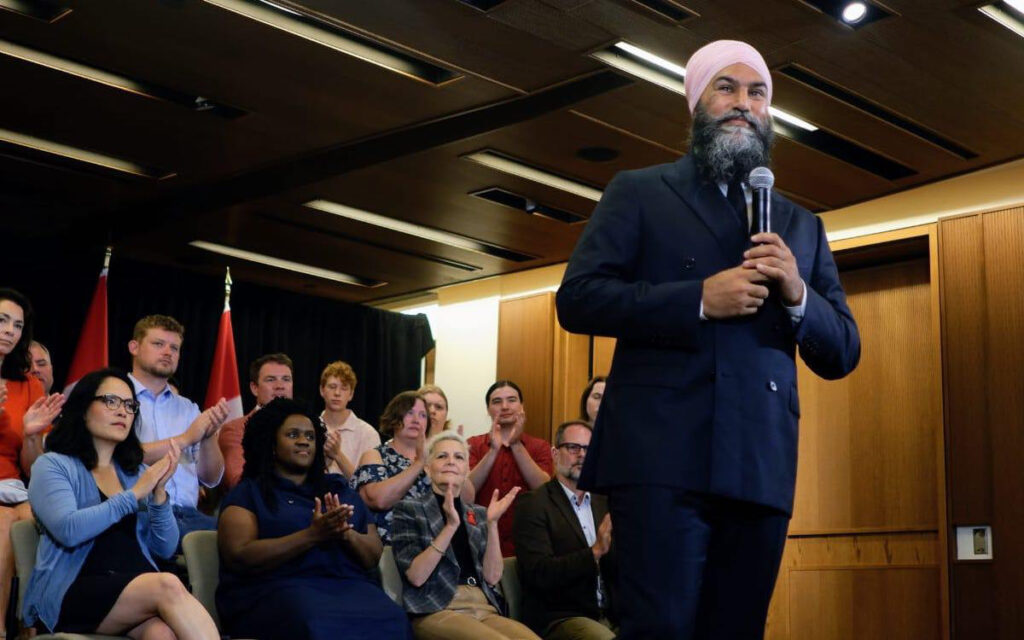
The political backrooms of the Liberals and NDPs are currently negotiating these measures behind closed doors. Their intent is to introduce electoral reform legislation this year to be implemented for the upcoming election – and, plainly, to allow for new campaign tactics that may improve their parties’ fortunes. Pictured: NDP leader Jagmeet Singh. Photo Credit: X/Jagmeet Singh.
The next federal election in October 2025 (should the Liberal-NDP confidence-and-supply deal hold) may feature increased use of mail-in ballots, a three-day voting period, and the ability to vote at any polling place. The political backrooms of the Liberals and NDPs are currently negotiating these measures behind closed doors. Their intent is to introduce electoral reform legislation this year to be implemented for the upcoming election – and, plainly, to allow for new campaign tactics that may improve their parties’ fortunes.
As leader of the third party in the 2015 federal general election, Prime Minister Justin Trudeau promised Canadians that, if the Liberals were elected, the country would never conduct another federal election with the first-past-the-post system. Yet, once elected with a solid majority, the Liberals dispensed with thoughts of wholesale electoral reform. Instead, the Trudeau Liberals only tinkered with the Election Act and were the beneficiaries of the established electoral system in the two subsequent elections, being re-elected to power even though the party failed in both elections to receive a majority of Canadian votes.
As it is, the Trudeau Liberals never have fulfilled their promise of comprehensive electoral reform, although in their first term of government they passed specific amendments that reversed changes made by the previous Harper government. The Liberals limited the campaign period to no longer than 50 days, fixed election dates and pre-writ periods, placed ceilings on parties’ pre-writ advertising, placed limits on the campaign activities of third-party organizations, and extended the voting rights of ex-patriate Canadians. Most significantly, the Liberals made the voter identification card a valid piece of identification to prove residency, and they allowed registered voters to “vouch” for the identity or residence of another voter at the polling station. In other words, voters no longer required government-issued photo identification.
This package of amendments was introduced into the House of Commons on April 30, 2018, and the legislation was rushed through Parliament to be given royal assent in mid-December. The government pushed the legislation through in response to Elections Canada’s warning that the changes had to be passed by the end of the year for the new measures to be adopted for the federal election scheduled for October 2019.
Fast-forward to 2024, where earlier this month, MPs voted down a motion for the federal government to establish a citizens’ assembly to “determine if electoral reform is recommended for Canada and, if so, recommend specific measures that would foster a healthier democracy.” The Trudeau cabinet along with a majority of Liberal and Conservative MPs voted against the motion, while the NDP, BQ, and Green MPs were joined with 40 Liberals and three Conservatives to vote for a public electoral reform review.
This MPs’ vote however has proven to be only half the story. While MPs were debating the merits of alternative systems of representation on the floor of the House of Commons, behind the curtains the Liberals were huddled with the NDP to agree on the contents of a new Elections Act legislation that could be quickly ferried through parliament, to be in place for the 2025 election. It’s the 2018 powerplay repeated.
The Liberal-NDP backroom negotiations were exposed in a CTV News interview with NDP MP Daniel Blaikie in late January. In the interview Blaikie states there has been “a fair amount of work done,” towards drafting amendments to the Elections Act. The Liberal government frontman in the negotiations, Public Safety, Democratic Institutions and Intergovernmental Affairs Minister Dominic LeBlanc, seemed annoyed with Blaikie’s public comment. When contacted, LeBlanc would only curtly confirm the legislative talks with the NDP and stated that the “next steps will be communicated in due course.”
CTV News reported that there are specific amendments being drawn up mirroring those electoral reforms that were initially discussed by PM Trudeau and NDP Leader Jagmeet Singh when signing their confidence-and-supply pact. The three key amendments are to 1) expand the voting period to three days, 2) allow voters to cast their ballots at any polling place, and 3) increase the use of mail-in ballots.
Blaikie alluded to the three amendments and the fact that the legislation is imminent, “I think people on both sides are keen to try and hammer out those final details and have a product that can be tabled in the House of Commons… I’m optimistic that we will have a bill that certainly includes ways of implementing what was in the [deal].”
Of the three reform initiatives the one that is garnering the greatest attention among political pundits is the increased use of mail-in ballots. The concern is that by expanding the use of mail-in ballots, voting in this manner will become normalized rather than being an exception granted to those who cannot physically travel or are unavailable to attend a voting station on election day.
In the United States through the past decade there has been growing use of mail-in ballots and they are now viewed as an integral part of a successful campaign strategy. Americans have seen serious issues relating to voter fraud, multiple ballots mailed to single addresses, and incidents of “ballot harvesting” with family members and friends. Both the Democrat and Republican parties employ tactics to increase their share of votes delivered through the mail. There has been a remarkable doubling of mail-in ballots from one election to the next: in the 2016 election, 21 per cent of American voters cast their ballot by mail and, in 2020, 43 per cent did so.
U.S. political analysts John Fund and Hans von Spakovsky wrote a book entitled “Our Broken Elections,” in which they observed that “the flood of millions of mail-in ballots opened the system to unprecedented confusion and largely untraceable fraud.” Verily, it has resulted in some states being declared for one party on election night, only to have a reverse declaration the next morning when the bags of mail-in ballots are opened.
It is not a stretch to think that the Liberals and NDP campaign teams have not contemplated the tactical advantages of increasing the use of mail-in ballots when they have both made use of political strategists from the Obama and Biden Democratic campaigns. Faced with the likelihood of being thrashed by the Conservatives at the ballot box, the Liberals’ and NDPs’ focus in the next election must be on electoral survival: shoring up support for incumbents by making close votes closer.
Mail-in ballots could make a marked difference in the outcome of the 2025 election. Consider that in the 2019 federal election, there were 45 seats decided by five per cent or less of the vote. In 2021, there were 46 seats decided by this slim margin.
So, watch for it: Dominic LeBlanc will rise in the House of Commons this spring to introduce electoral reform legislation that will “strengthen our democracy” by “allowing more Canadians the opportunity to vote.” And it will be déjà vu all over again. The legislation will be pushed through parliament just in time to be implemented in the election.
REMINDER: Next week marks the 40th anniversary of Pierre Trudeau’s resignation from politics. There is no snow in the Ottawa forecast, but this scribe again makes his claim Justin Trudeau will follow in his father’s footsteps to make a dramatic announcement on the notorious February 29th date. The deciding factor for the PM is that he shares with his father the precarious position of being 20 points behind his Conservative opposition with no realistic chance of climbing back. (There are simply not enough mail-in ballots that can be printed to reverse his political fate).

Chris George is an advocate, government relations advisor, and writer/copy editor. As president of a public relations firm established in 1994, Chris provides discreet counsel, tactical advice and management skills to CEOs/Presidents, Boards of Directors and senior executive teams in executing public and government relations campaigns and managing issues. Prior to this PR/GR career, Chris spent seven years on Parliament Hill on staffs of Cabinet Ministers and MPs. He has served in senior campaign positions for electoral and advocacy campaigns at every level of government. Today, Chris resides in Almonte, Ontario where he and his wife manage www.cgacommunications.com. Contact Chris at chrisg.george@gmail.com.




















